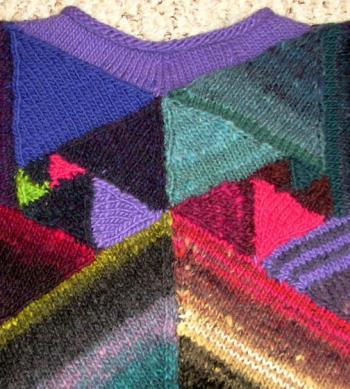Amazingly, I also got a question about how to make the triangles. Ann has already written about this. But there are many methods that work sort of OK. Ginger Luters’ book, Module Magic shows methods for knitting equilateral triangles in garter, garter ridge and stockinette stitches. There are also general directions for determining a decrease sequence for other stitch patterns. Colleen Davis’ pattern, Triangle Mambo Sunset recommends you perform a [k1, ssk,…,k2t,k1] on every other RS row and alternating [k1,ssk…] and […,k2t,k1] on the other RS rows in stockinette.
However, I soon switched to [k1,k2t…] at the beginning of the rows and […ssk,k1] at the end of the rows because that keeps the stitches vertical over most of the triangle. Click on the picture below to see the detail. The large triangle on the bottom L is worked in Colleen Davis’ way, most of the rest of the triangles are worked in my method.

For stockinette stitch, Ginger Luters recommends decreasing 1 stitch in from each end on each RS row. I didn’t try that method, but can attest that Colleen Davis’ sequence makes an equilateral triangle without need for agressive blocking.
When I wore this sweater at a quilt show, a lady stopped me to ask how I picked up the stitches around the triangles. She had bought the same pattern but worried that picking up stitches the normal way, one stitch in, would distort the fabric when the triangles start out at only 6 stitches wide. The pattern called for making triangles starting with 6, 12, 18, … stitches. I wondered the same thing. Rather than adjust the number of stitches cast-on or picked-up, I just picked-up through one strand of the edge stitch only.
The triangles are picked-up, log-cabin style until you have a piece that resembles the right or left side of a sweater front or back. Page 35 of Module Magic happens to have a diagram that is identical to one of the pieces of Triangle Mambo Sunset!. Maybe this is an old, well-known technique and I don’t need to write any more about this in my sister’s blog.
Rather than knit a partial triangle to fill in the center back neck, I picked-up stitches all around, short-rowed the front and decreased when it seemed appropriate at the CB. It looks nice and smooth even though I didn’t do any calculating. Knitting is so forgiving.
Math Aside:
Row 1 is always the pick-up or cast-on row and on the RS (I used a multiple of 6)
WS Rows always P across
Type A: (sts,mod 3) = 0 or 3n stitches on needle, [k1,k2t,…,ssk,k1]
Type B: 6n+1 sts on needle, [k1, k2t, k to end]
Type C: 6n-2 sts on needle, [knit to last 3 sts, ssk, k1]



